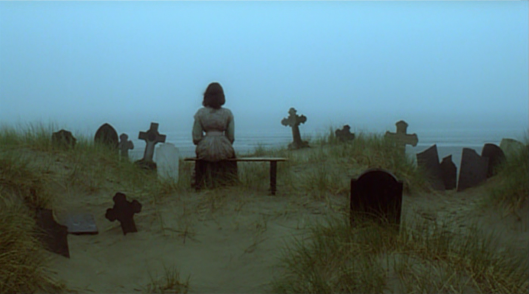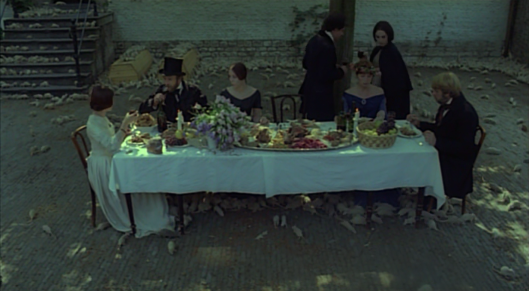Sometimes a horror film comes along that’s just beautiful. These are the films I want to get out and show to people who look down on the genre and its fans, to prove that no, horror can be an art form. The remake of Nosferatu is one such film. Of course I love the original; it’s a wonderfully creepy film that’s inspired so many subsequent tales of vampire lore. One of the greatest things about the 1979 version though is that it doesn’t attempt an exact remake, nor does it go down the unfortunate ‘gore and sex’ route that so many remakes take. The film takes the basic plot and the doom-laden atmosphere of the silent film to create something totally new.  The basic story will be familiar to most people. Jonathan Harker is asked to go to Count Dracula’s castle in order to sell the nobleman a home in Varna, where Jonathan lives with his wife, Lucy. The count, of course, is a vampire, and he travels to Varna bringing death and plague with him. Jonathan returns as well, but his mind is broken and he doesn’t remember his wife, leaving Lucy to stop Dracula before they all fall victim to him.
The basic story will be familiar to most people. Jonathan Harker is asked to go to Count Dracula’s castle in order to sell the nobleman a home in Varna, where Jonathan lives with his wife, Lucy. The count, of course, is a vampire, and he travels to Varna bringing death and plague with him. Jonathan returns as well, but his mind is broken and he doesn’t remember his wife, leaving Lucy to stop Dracula before they all fall victim to him.
One of the first things to acknowledge about the film is how stunning the cinematography is. From the first shots of mummified bodies in catacombs and a bat shot in slow motion, you know that this film is going to be something different. Every scene is like a work of art. Also, I love how the bleak European landscapes compliment the melancholic, doom-laden atmosphere of the film.
Klaus Kinski takes on the title role, and while I didn’t find him as creepy as the original Nosferatu, he brought a pathos to the role which I wasn’t expecting. You really feel like the count is under a terrible curse that he would do anything to escape from. “Time is an abyss,” he tells Lucy, “profound as a thousand nights… Centuries come and go… To be unable to grow old is terrible… Death is not the worst… Can you imagine enduring centuries, experiencing each day the same futilities…” He is evil, but he is also a creature that is deeply lonely, and craves something deeper than blood. He envies the love that Lucy and Jonathan share, but he is cast out, spreading death wherever he goes.
The other revelation is Isabelle Adjani as Lucy. For one, she is simply gorgeous. I couldn’t take my eyes off her when she was on screen. Also, she is a much more proactive character than the original. When Dracula comes to Varna, Lucy is the only one who sees the truth behind the mysterious plague that is killing off the citizens. Van Helsing does make an appearance, but he is pretty useless, blinded by logic and refusing to listen to anything other than a scientific explanation. Lucy is the one who investigates the vampire myth, and sacrifices herself to destroy Dracula. The one thing I really loved was the way that Lucy was strong in a very feminine way. A lot of films feel the need to have a ‘strong female character’ act in a stereotypically masculine way – she is tough, she doesn’t pander to her emotions, she throws punches. This is all well and good, but it would be really nice to see different types of female strength. Lucy is gentle, her tenderness towards her poor catatonic husband never falters, and she understands that it is through surrender and not violence that Dracula must be destroyed. The scene when she lets him feed from her is beautiful, especially when he becomes aware that dawn is approaching and starts to move away, but she gently pulls him back in, almost like a mother suckling her child.
I loved the representation of the townspeople after Dracula’s arrival in Varna. There’s a real ‘end of days’ feel to it – these people feel that they are going to die, they are resigned to it, and they have given themselves over to decadence. Farm animals run wild in the town square, and families hold elaborate dinner parties in the street as a ‘last supper’.
Okay, I want to talk about the ending, which is another big break from the original, but it’s a pretty massive spoiler. But I really want to talk about it. Okay, so, major spoiler warning coming up, if you haven’t seen it and don’t want the ending ruined, don’t read beyond the following screencap.
Either way, this is a stunning film that should absolutely not be missed.
Okay, so while the 1920s Nosferatu culminates with the count’s destruction by the rising sun after feeding on Lucy, this version has an additional scene. After Dracula’s death, Jonathan Harker returns to his senses, only he is now a vampire. His looks are becoming increasingly similar to Dracula’s, and the final scene has him galloping off on horseback, presumably to return to the castle he’d tried so desperately to escape from.
Right so here’s what I’ve been wondering. I noticed that earlier in the film when Harker is exploring the castle, he comes across several abandoned rooms with desks in states of disrepair before he finds the one assigned to him. So… is this the first time this has happened, or have there been others? Is the Dracula we meet the original vampire, or is he another lost soul like Jonathan who came to the castle and inherited the curse? Does it get passed on when the previous vampire dies, so that each victim has to take on the role of the count? That may not have been the intention at all, but it was something that occurred to me the last time I watched the film, and I’d be really interested to know what other people thought.





